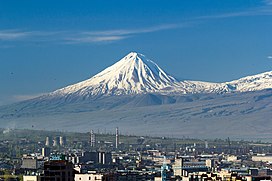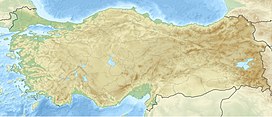|
Little Ararat
Little Ararat[a] (Armenian: Փոքր Արարատ, romanized: Pok'r Ararat; Turkish: Küçük Ağrı; Kurdish: Agiriyê Biçûk) is the sixth-tallest peak and a stratovolcano in Turkey. It is a large satellite cone located on the eastern flank of the massive Mount Ararat, less than 5 mi (8.0 km) west of Turkey’s border with Iran. Despite being dwarfed by its higher and far more famous neighbor, Little Ararat is a significant volcano in its own right, with an almost perfectly symmetrical, conical form and smooth constructional slopes.[citation needed] Little Ararat rises about 1,296 m (4,252 ft) above the Serdarbulak lava plateau, which forms a saddle connecting it with the main peak.[2] HistoryOn 8 November [O.S. 27 October] 1829, Baltic German explorer Friedrich Parrot and Armenian writer Khachatur Abovian climbed Little Ararat.[3] Its eastern flank was on the Iranian side of the border until the early 1930s. During the Kurdish Ararat rebellion, Kurdish rebels used the area "as a haven against the state in their uprising."[4] Turkey crossed the border and militarily occupied the region, which Iran eventually agreed to cede to Ankara in a territorial exchange.[5][6] The related treaty was signed on 23 January 1932.[7] See alsoReferencesCitations
NotesSources
|
||||||||||||||||||||||||
Portal di Ensiklopedia Dunia

